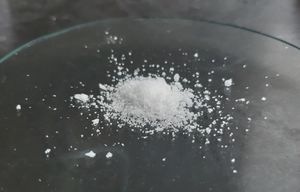Camphor
From Sciencemadness Wiki
 Camphor crystals
| |
| Names | |
|---|---|
| IUPAC name
1,7,7-Trimethylbicyclo[2.2.1]heptan-2-one
| |
| Other names
2-Bornanone
Bornan-2-one 2-Camphanone Formosa | |
| Properties | |
| C10H16O | |
| Molar mass | 152.237 g/mol |
| Appearance | White solid |
| Odor | Fragrant and penetrating |
| Density | 0.992 g/cm3 |
| Melting point | 175–177 °C (347–351 °F; 448–450 K) |
| Boiling point | 209 °C (408 °F; 482 K) |
| 0.12 g/100 ml | |
| Solubility | Soluble in benzene, carbon disulfide, chloroform, diethyl ether, ethanol |
| Vapor pressure | 4 mmHg (at 70 °C) |
| Hazards | |
| Safety data sheet | Sigma-Aldrich (racemic) |
| Flash point | 54 °C (129 °F; 327 K) |
| Lethal dose or concentration (LD, LC): | |
| LD50 (Median dose)
|
1310 mg/kg (oral, mouse) |
| Related compounds | |
| Related compounds
|
Borneol |
| Except where otherwise noted, data are given for materials in their standard state (at 25 °C [77 °F], 100 kPa). | |
| Infobox references | |
Camphor is an organic compound, a terpenoid, a waxy, flammable, transparent solid with a strong aroma.
The molecule has two possible enantiomers as shown in the structural diagrams. The structure on the left is the naturally occurring (R)-form, while its mirror image shown on the right is the (S)-form.
Contents
Properties
Chemical
Camphor can be oxidized with concentrated nitric acid.
Physical
Camphor is a waxy, transparent solid with a strong aroma. It is almost insoluble in water.
Availability
Camphor can be bought from lab suppliers.
Preparation
Camphor is best bought than made.
Projects
- Make borneol
Handling
Safety
May be irritant.
Storage
In closed bottles.
Disposal
No special disposal is required.